FORD TRANSIT CONNECT 2010 1.G Owners Manual
Manufacturer: FORD, Model Year: 2010, Model line: TRANSIT CONNECT, Model: FORD TRANSIT CONNECT 2010 1.GPages: 258, PDF Size: 1.98 MB
Page 181 of 258
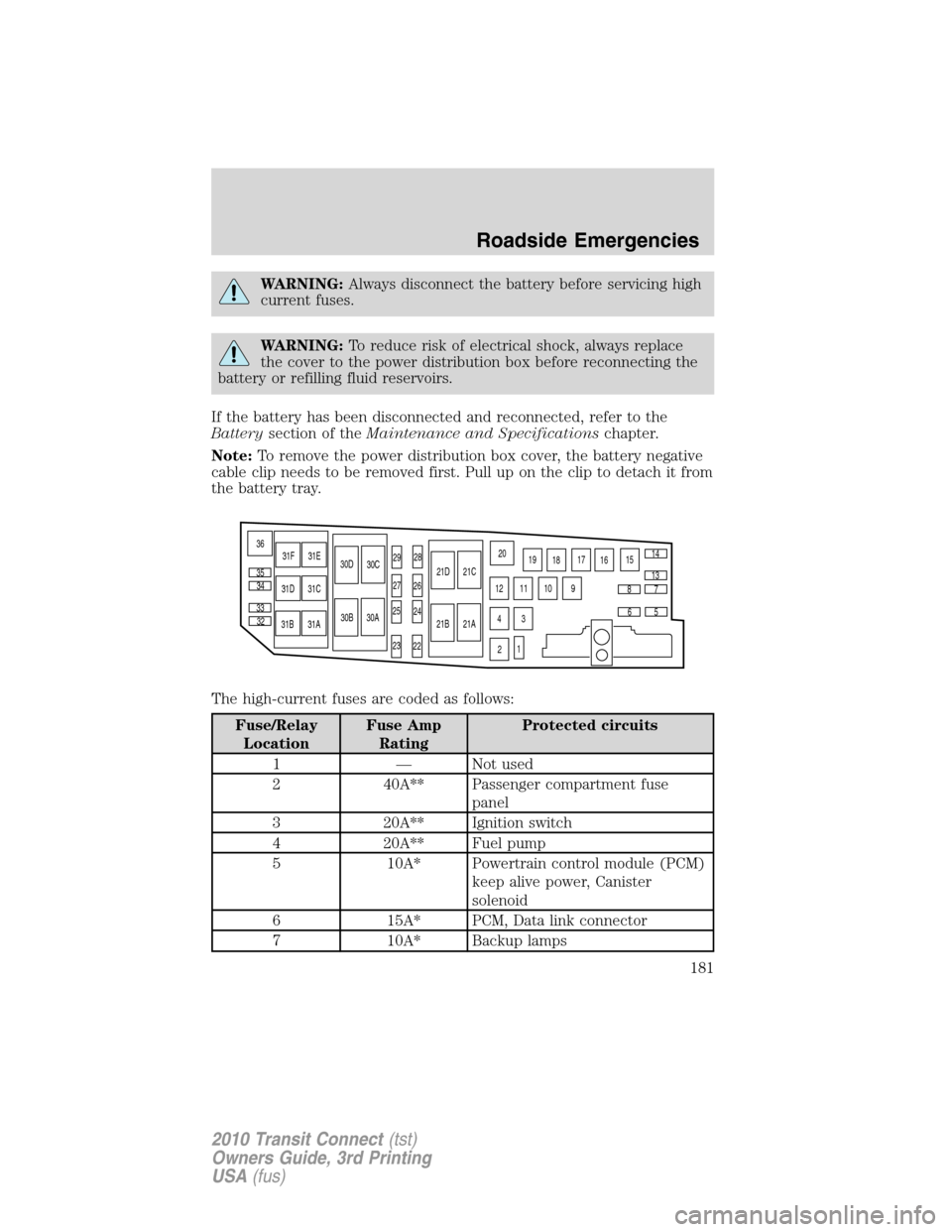
WARNING:Always disconnect the battery before servicing high
current fuses.
WARNING:To reduce risk of electrical shock, always replace
the cover to the power distribution box before reconnecting the
battery or refilling fluid reservoirs.
If the battery has been disconnected and reconnected, refer to the
Batterysection of theMaintenance and Specificationschapter.
Note:To remove the power distribution box cover, the battery negative
cable clip needs to be removed first. Pull up on the clip to detach it from
the battery tray.
The high-current fuses are coded as follows:
Fuse/Relay
LocationFuse Amp
RatingProtected circuits
1 — Not used
2 40A** Passenger compartment fuse
panel
3 20A** Ignition switch
4 20A** Fuel pump
5 10A* Powertrain control module (PCM)
keep alive power, Canister
solenoid
6 15A* PCM, Data link connector
7 10A* Backup lamps
25
24
22 2326 2728
29
21A
21B21C
21D
30A
30B30C 30D
31A
31B31C 31D31E 31F
32 3334 35 36
15
16 17
18 19 20
10 11 12
9
3 4
1
25
67 81314
Roadside Emergencies
181
2010 Transit Connect(tst)
Owners Guide, 3rd Printing
USA(fus)
Page 182 of 258
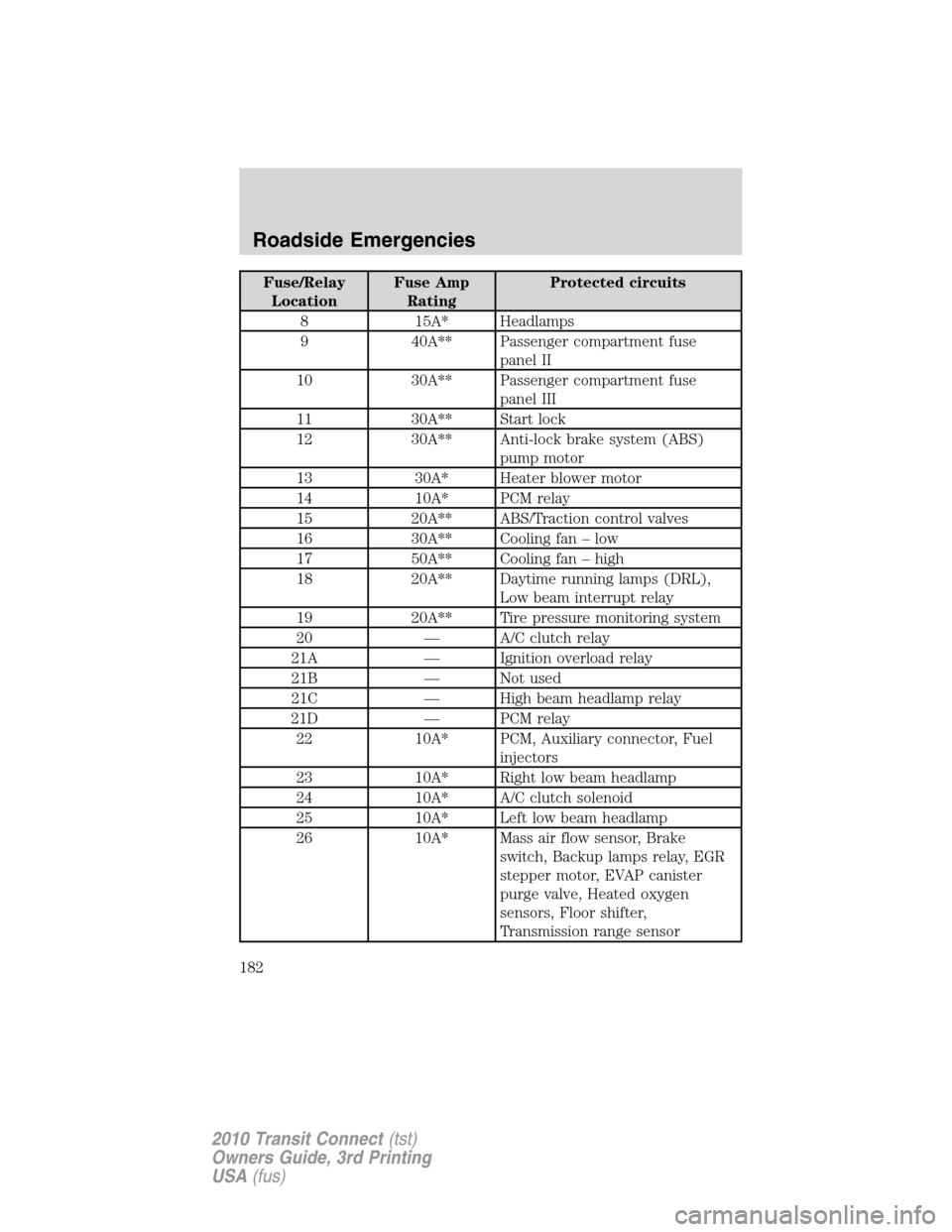
Fuse/Relay
LocationFuse Amp
RatingProtected circuits
8 15A* Headlamps
9 40A** Passenger compartment fuse
panel II
10 30A** Passenger compartment fuse
panel III
11 30A** Start lock
12 30A** Anti-lock brake system (ABS)
pump motor
13 30A* Heater blower motor
14 10A* PCM relay
15 20A** ABS/Traction control valves
16 30A** Cooling fan – low
17 50A** Cooling fan – high
18 20A** Daytime running lamps (DRL),
Low beam interrupt relay
19 20A** Tire pressure monitoring system
20 — A/C clutch relay
21A — Ignition overload relay
21B — Not used
21C — High beam headlamp relay
21D — PCM relay
22 10A* PCM, Auxiliary connector, Fuel
injectors
23 10A* Right low beam headlamp
24 10A* A/C clutch solenoid
25 10A* Left low beam headlamp
26 10A* Mass air flow sensor, Brake
switch, Backup lamps relay, EGR
stepper motor, EVAP canister
purge valve, Heated oxygen
sensors, Floor shifter,
Transmission range sensor
Roadside Emergencies
182
2010 Transit Connect(tst)
Owners Guide, 3rd Printing
USA(fus)
Page 183 of 258
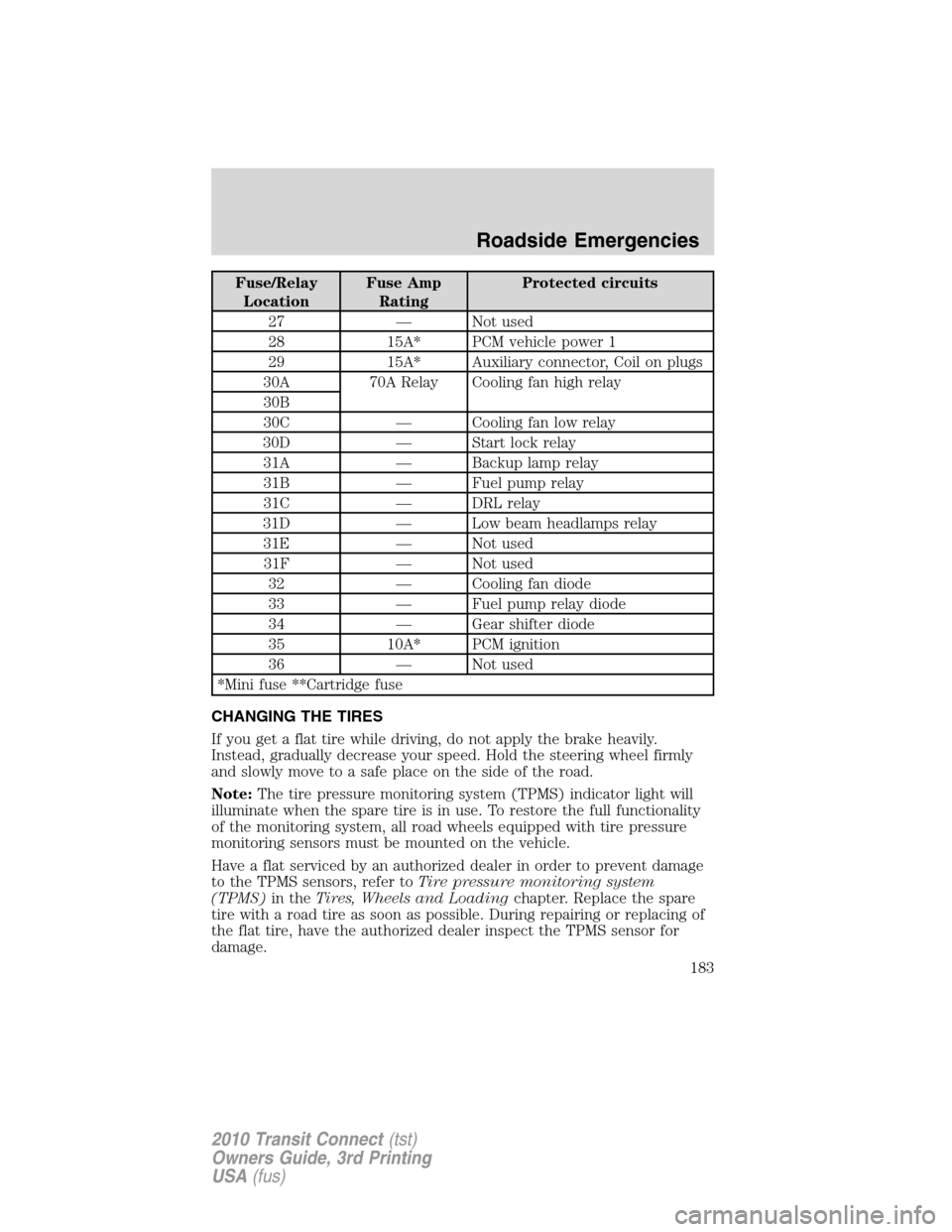
Fuse/Relay
LocationFuse Amp
RatingProtected circuits
27 — Not used
28 15A* PCM vehicle power 1
29 15A* Auxiliary connector, Coil on plugs
30A 70A Relay Cooling fan high relay
30B
30C — Cooling fan low relay
30D — Start lock relay
31A — Backup lamp relay
31B — Fuel pump relay
31C — DRL relay
31D — Low beam headlamps relay
31E — Not used
31F — Not used
32 — Cooling fan diode
33 — Fuel pump relay diode
34 — Gear shifter diode
35 10A* PCM ignition
36 — Not used
*Mini fuse **Cartridge fuse
CHANGING THE TIRES
If you get a flat tire while driving, do not apply the brake heavily.
Instead, gradually decrease your speed. Hold the steering wheel firmly
and slowly move to a safe place on the side of the road.
Note:The tire pressure monitoring system (TPMS) indicator light will
illuminate when the spare tire is in use. To restore the full functionality
of the monitoring system, all road wheels equipped with tire pressure
monitoring sensors must be mounted on the vehicle.
Have a flat serviced by an authorized dealer in order to prevent damage
to the TPMS sensors, refer toTire pressure monitoring system
(TPMS)in theTires, Wheels and Loadingchapter. Replace the spare
tire with a road tire as soon as possible. During repairing or replacing of
the flat tire, have the authorized dealer inspect the TPMS sensor for
damage.
Roadside Emergencies
183
2010 Transit Connect(tst)
Owners Guide, 3rd Printing
USA(fus)
Page 184 of 258
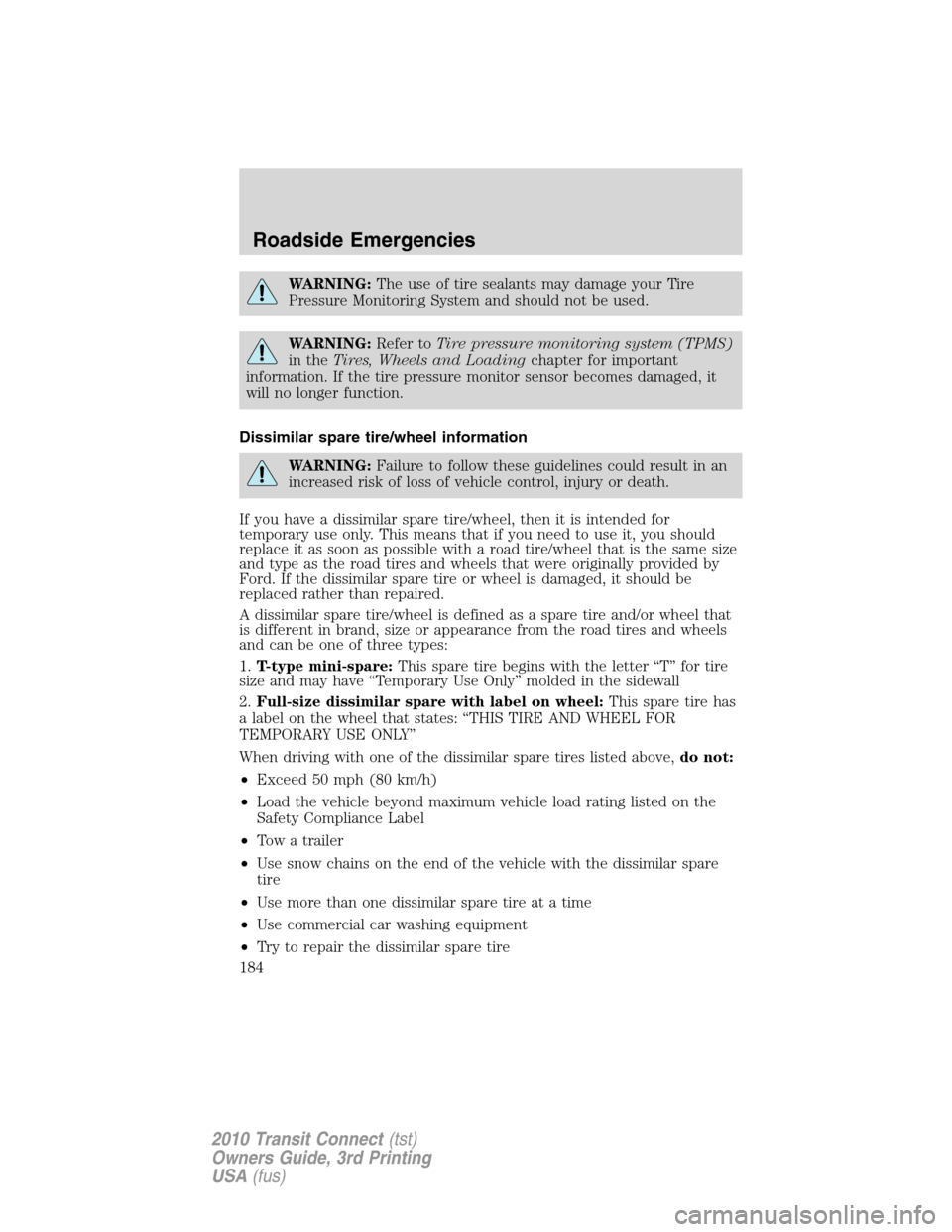
WARNING:The use of tire sealants may damage your Tire
Pressure Monitoring System and should not be used.
WARNING:Refer toTire pressure monitoring system (TPMS)
in theTires, Wheels and Loadingchapter for important
information. If the tire pressure monitor sensor becomes damaged, it
will no longer function.
Dissimilar spare tire/wheel information
WARNING:Failure to follow these guidelines could result in an
increased risk of loss of vehicle control, injury or death.
If you have a dissimilar spare tire/wheel, then it is intended for
temporary use only. This means that if you need to use it, you should
replace it as soon as possible with a road tire/wheel that is the same size
and type as the road tires and wheels that were originally provided by
Ford. If the dissimilar spare tire or wheel is damaged, it should be
replaced rather than repaired.
A dissimilar spare tire/wheel is defined as a spare tire and/or wheel that
is different in brand, size or appearance from the road tires and wheels
and can be one of three types:
1.T-type mini-spare:This spare tire begins with the letter “T” for tire
size and may have “Temporary Use Only” molded in the sidewall
2.Full-size dissimilar spare with label on wheel:This spare tire has
a label on the wheel that states: “THIS TIRE AND WHEEL FOR
TEMPORARY USE ONLY”
When driving with one of the dissimilar spare tires listed above,do not:
•Exceed 50 mph (80 km/h)
•Load the vehicle beyond maximum vehicle load rating listed on the
Safety Compliance Label
•Tow a trailer
•Use snow chains on the end of the vehicle with the dissimilar spare
tire
•Use more than one dissimilar spare tire at a time
•Use commercial car washing equipment
•Try to repair the dissimilar spare tire
Roadside Emergencies
184
2010 Transit Connect(tst)
Owners Guide, 3rd Printing
USA(fus)
Page 185 of 258
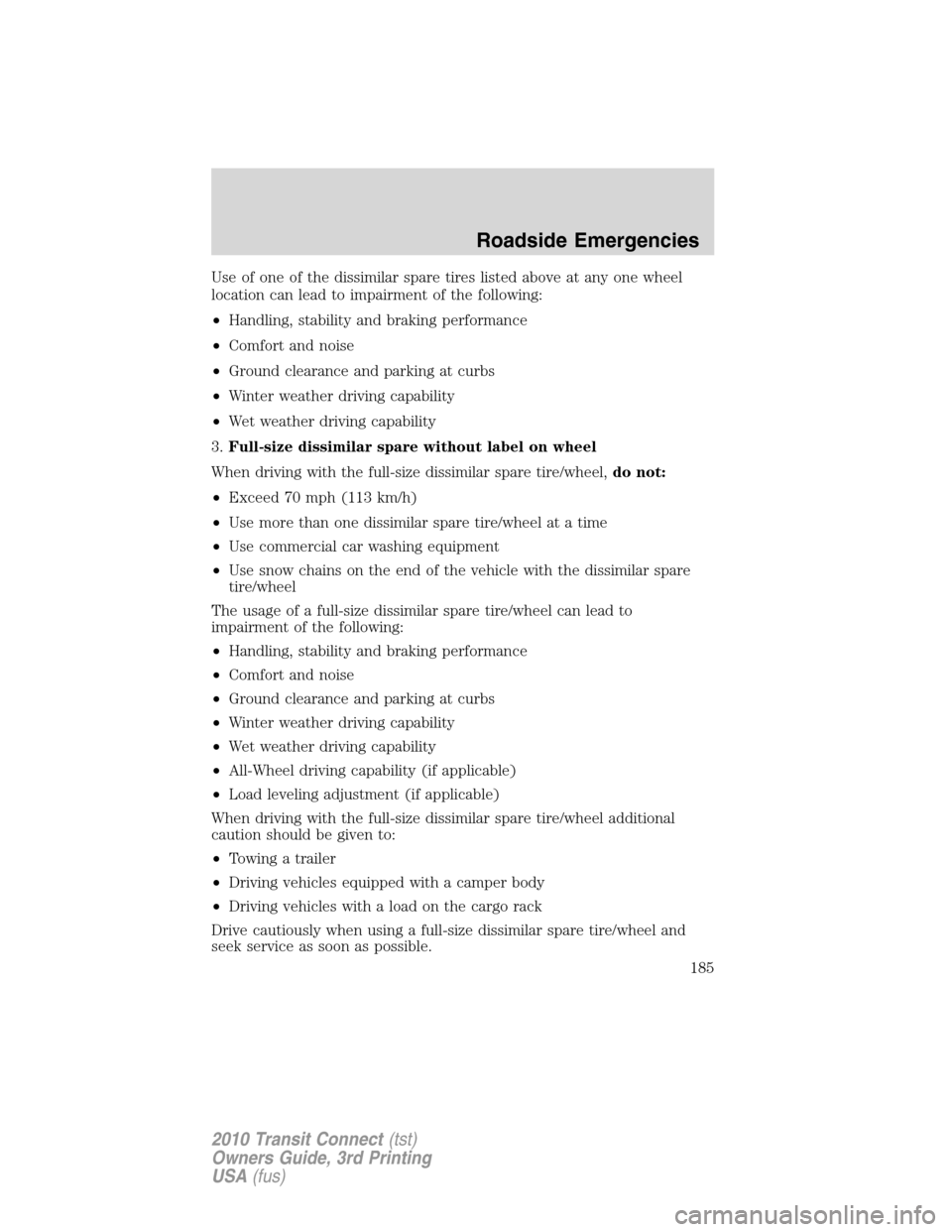
Use of one of the dissimilar spare tires listed above at any one wheel
location can lead to impairment of the following:
•Handling, stability and braking performance
•Comfort and noise
•Ground clearance and parking at curbs
•Winter weather driving capability
•Wet weather driving capability
3.Full-size dissimilar spare without label on wheel
When driving with the full-size dissimilar spare tire/wheel,do not:
•Exceed 70 mph (113 km/h)
•Use more than one dissimilar spare tire/wheel at a time
•Use commercial car washing equipment
•Use snow chains on the end of the vehicle with the dissimilar spare
tire/wheel
The usage of a full-size dissimilar spare tire/wheel can lead to
impairment of the following:
•Handling, stability and braking performance
•Comfort and noise
•Ground clearance and parking at curbs
•Winter weather driving capability
•Wet weather driving capability
•All-Wheel driving capability (if applicable)
•Load leveling adjustment (if applicable)
When driving with the full-size dissimilar spare tire/wheel additional
caution should be given to:
•Towing a trailer
•Driving vehicles equipped with a camper body
•Driving vehicles with a load on the cargo rack
Drive cautiously when using a full-size dissimilar spare tire/wheel and
seek service as soon as possible.
Roadside Emergencies
185
2010 Transit Connect(tst)
Owners Guide, 3rd Printing
USA(fus)
Page 186 of 258
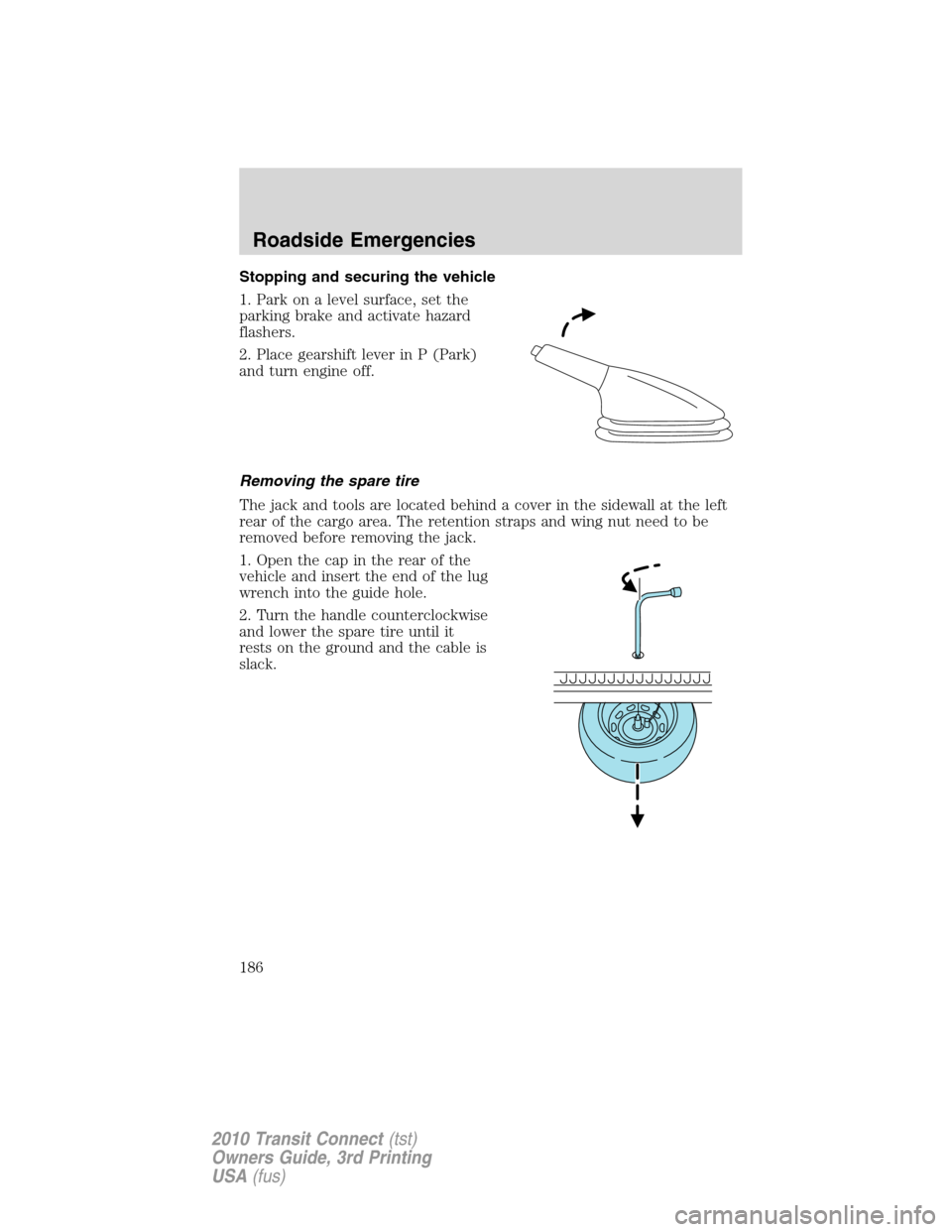
Stopping and securing the vehicle
1. Park on a level surface, set the
parking brake and activate hazard
flashers.
2. Place gearshift lever in P (Park)
and turn engine off.
Removing the spare tire
The jack and tools are located behind a cover in the sidewall at the left
rear of the cargo area. The retention straps and wing nut need to be
removed before removing the jack.
1. Open the cap in the rear of the
vehicle and insert the end of the lug
wrench into the guide hole.
2. Turn the handle counterclockwise
and lower the spare tire until it
rests on the ground and the cable is
slack.
Roadside Emergencies
186
2010 Transit Connect(tst)
Owners Guide, 3rd Printing
USA(fus)
Page 187 of 258
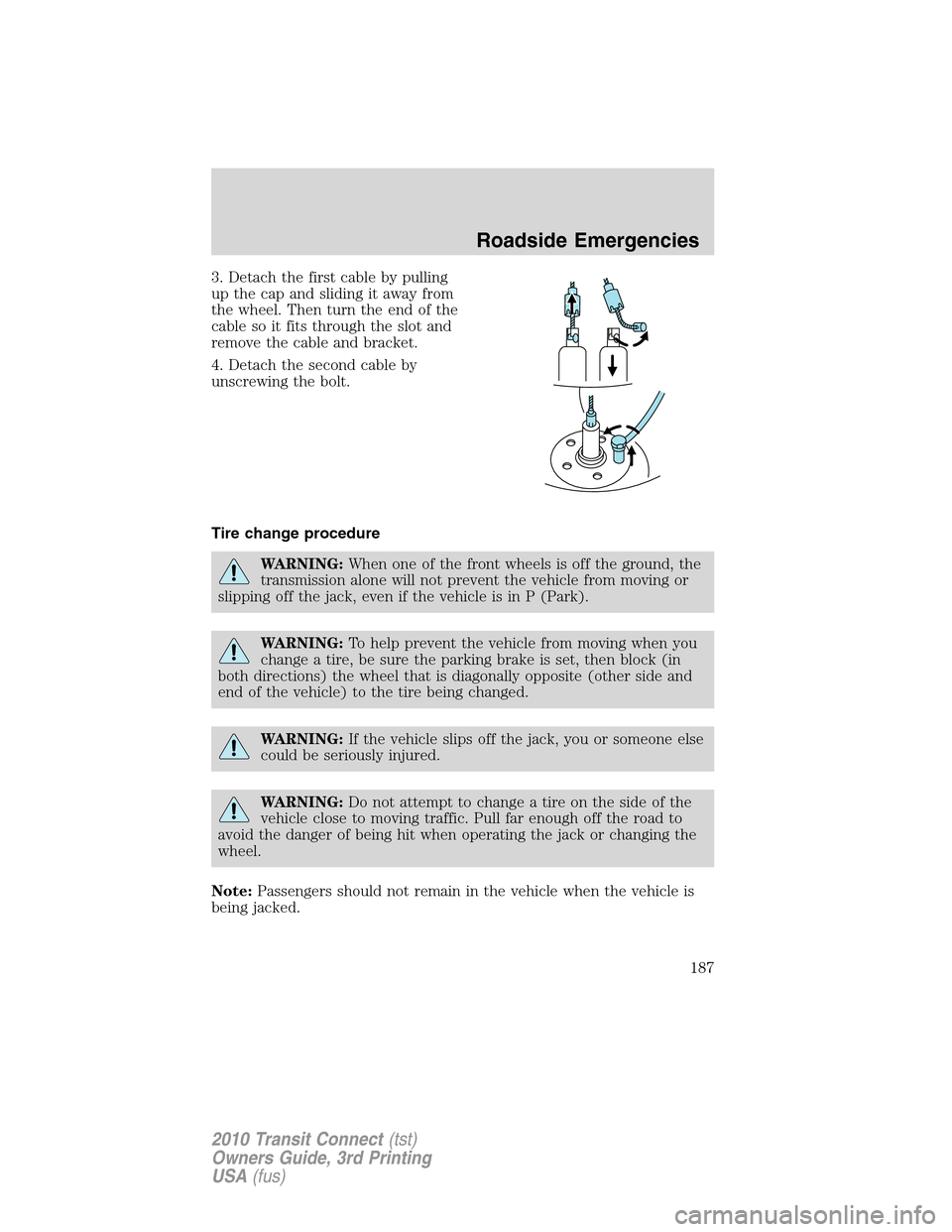
3. Detach the first cable by pulling
up the cap and sliding it away from
the wheel. Then turn the end of the
cable so it fits through the slot and
remove the cable and bracket.
4. Detach the second cable by
unscrewing the bolt.
Tire change procedure
WARNING:When one of the front wheels is off the ground, the
transmission alone will not prevent the vehicle from moving or
slipping off the jack, even if the vehicle is in P (Park).
WARNING:To help prevent the vehicle from moving when you
change a tire, be sure the parking brake is set, then block (in
both directions) the wheel that is diagonally opposite (other side and
end of the vehicle) to the tire being changed.
WARNING:If the vehicle slips off the jack, you or someone else
could be seriously injured.
WARNING:Do not attempt to change a tire on the side of the
vehicle close to moving traffic. Pull far enough off the road to
avoid the danger of being hit when operating the jack or changing the
wheel.
Note:Passengers should not remain in the vehicle when the vehicle is
being jacked.
Roadside Emergencies
187
2010 Transit Connect(tst)
Owners Guide, 3rd Printing
USA(fus)
Page 188 of 258
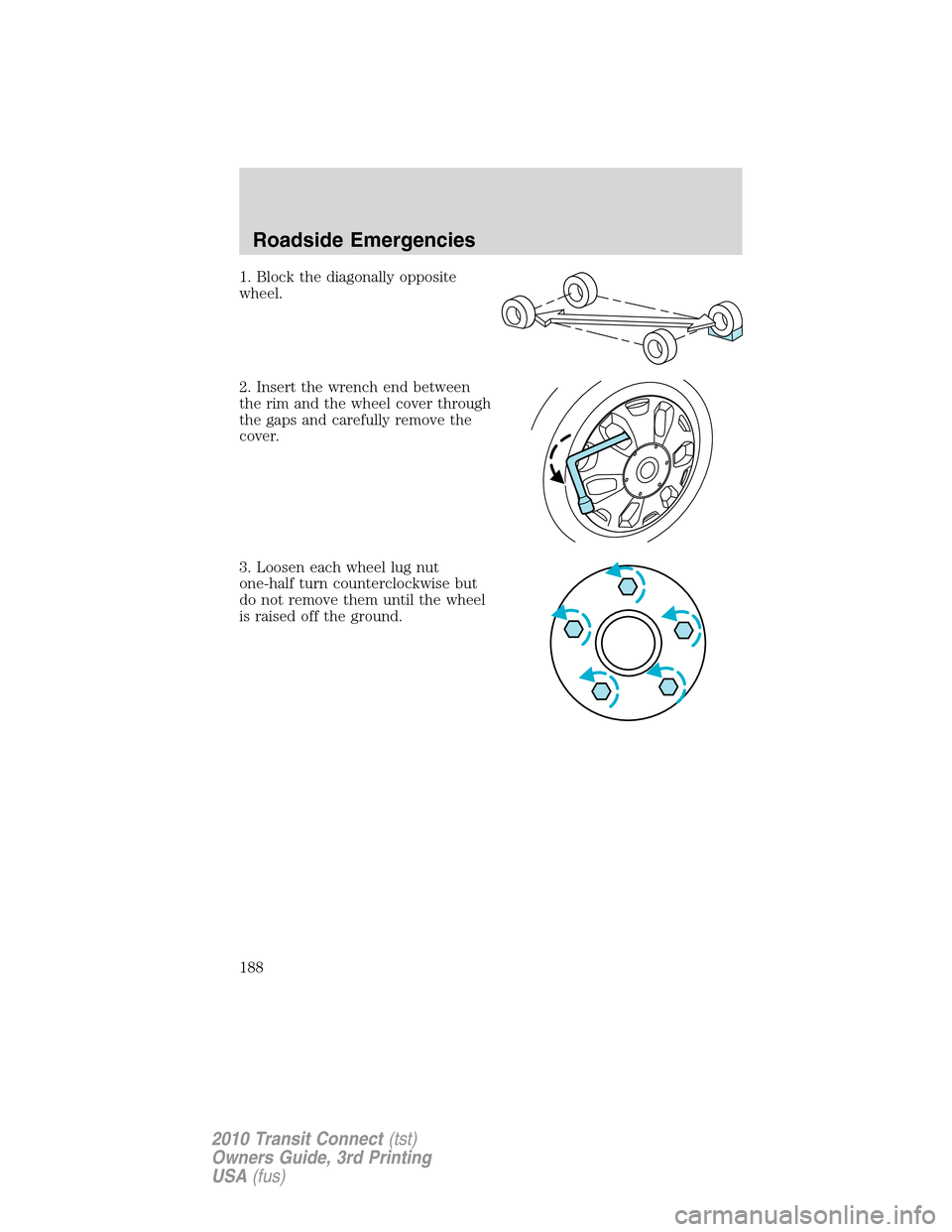
1. Block the diagonally opposite
wheel.
2. Insert the wrench end between
the rim and the wheel cover through
the gaps and carefully remove the
cover.
3. Loosen each wheel lug nut
one-half turn counterclockwise but
do not remove them until the wheel
is raised off the ground.
Roadside Emergencies
188
2010 Transit Connect(tst)
Owners Guide, 3rd Printing
USA(fus)
Page 189 of 258
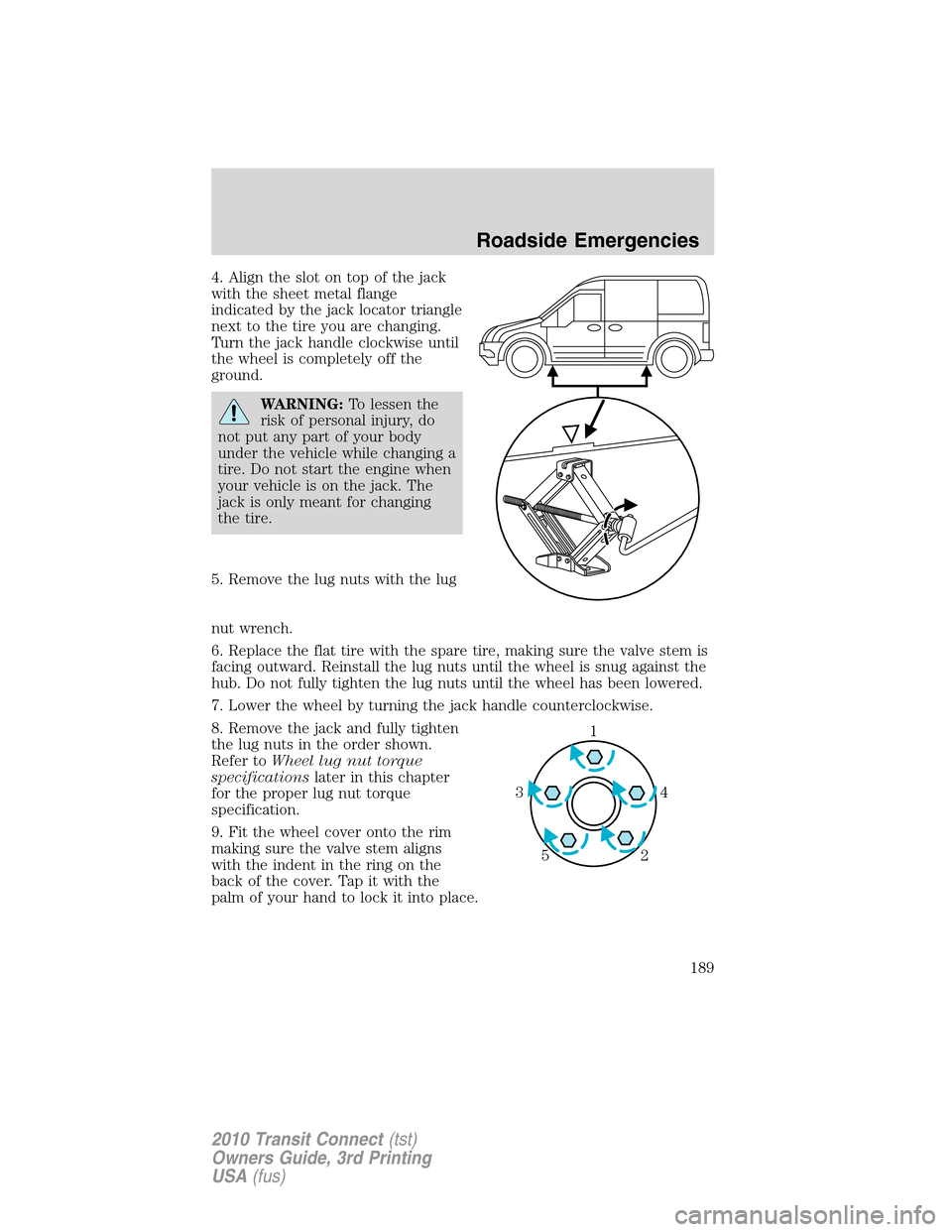
4. Align the slot on top of the jack
with the sheet metal flange
indicated by the jack locator triangle
next to the tire you are changing.
Turn the jack handle clockwise until
the wheel is completely off the
ground.
WARNING:To lessen the
risk of personal injury, do
not put any part of your body
under the vehicle while changing a
tire. Do not start the engine when
your vehicle is on the jack. The
jack is only meant for changing
the tire.
5. Remove the lug nuts with the lug
nut wrench.
6. Replace the flat tire with the spare tire, making sure the valve stem is
facing outward. Reinstall the lug nuts until the wheel is snug against the
hub. Do not fully tighten the lug nuts until the wheel has been lowered.
7. Lower the wheel by turning the jack handle counterclockwise.
8. Remove the jack and fully tighten
the lug nuts in the order shown.
Refer toWheel lug nut torque
specificationslater in this chapter
for the proper lug nut torque
specification.
9. Fit the wheel cover onto the rim
making sure the valve stem aligns
with the indent in the ring on the
back of the cover. Tap it with the
palm of your hand to lock it into place.
1
4 3
2 5
Roadside Emergencies
189
2010 Transit Connect(tst)
Owners Guide, 3rd Printing
USA(fus)
Page 190 of 258
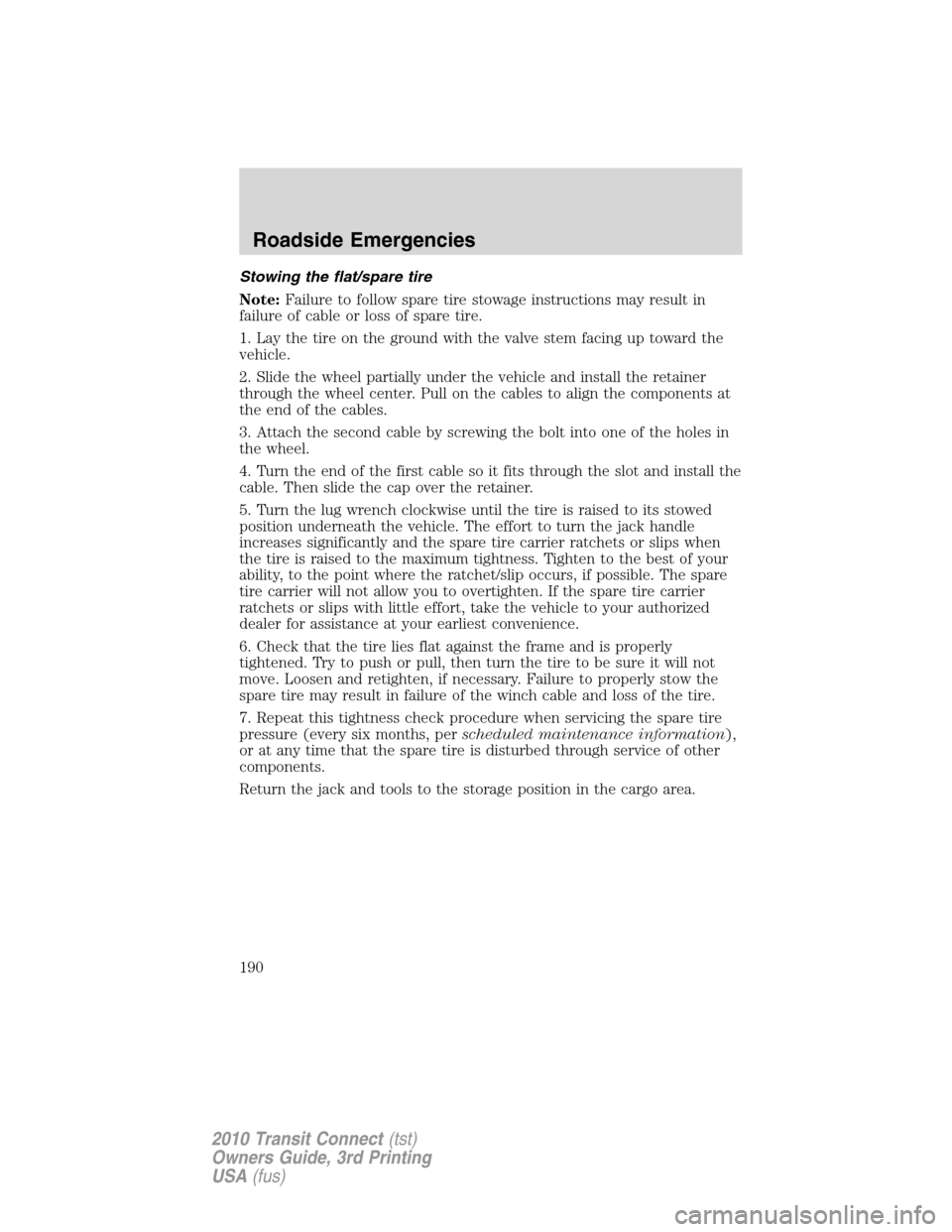
Stowing the flat/spare tire
Note:Failure to follow spare tire stowage instructions may result in
failure of cable or loss of spare tire.
1. Lay the tire on the ground with the valve stem facing up toward the
vehicle.
2. Slide the wheel partially under the vehicle and install the retainer
through the wheel center. Pull on the cables to align the components at
the end of the cables.
3. Attach the second cable by screwing the bolt into one of the holes in
the wheel.
4. Turn the end of the first cable so it fits through the slot and install the
cable. Then slide the cap over the retainer.
5. Turn the lug wrench clockwise until the tire is raised to its stowed
position underneath the vehicle. The effort to turn the jack handle
increases significantly and the spare tire carrier ratchets or slips when
the tire is raised to the maximum tightness. Tighten to the best of your
ability, to the point where the ratchet/slip occurs, if possible. The spare
tire carrier will not allow you to overtighten. If the spare tire carrier
ratchets or slips with little effort, take the vehicle to your authorized
dealer for assistance at your earliest convenience.
6. Check that the tire lies flat against the frame and is properly
tightened. Try to push or pull, then turn the tire to be sure it will not
move. Loosen and retighten, if necessary. Failure to properly stow the
spare tire may result in failure of the winch cable and loss of the tire.
7. Repeat this tightness check procedure when servicing the spare tire
pressure (every six months, perscheduled maintenance information),
or at any time that the spare tire is disturbed through service of other
components.
Return the jack and tools to the storage position in the cargo area.
Roadside Emergencies
190
2010 Transit Connect(tst)
Owners Guide, 3rd Printing
USA(fus)